2014 MERCEDES-BENZ SLK ROADSTER light
[x] Cancel search: lightPage 322 of 357
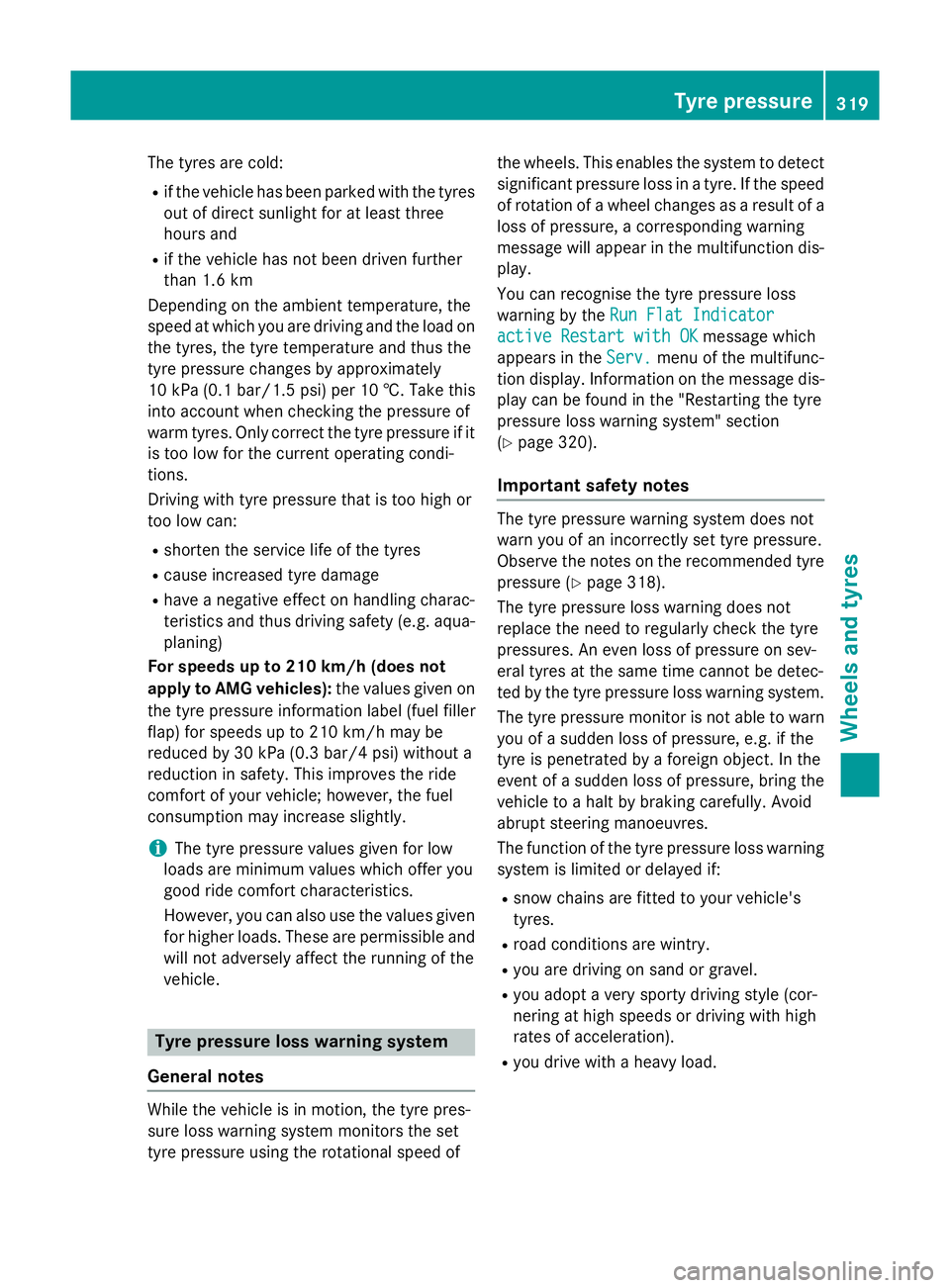
The tyres are cold:
R if the vehicle has been parked with the tyres
out of direct sunlight for at least three
hours and
R if the vehicle has not been driven further
than 1.6 km
Depending on the ambient temperature, the
speed at which you are driving and the load on the tyres, the tyre temperature and thus the
tyre pressure changes by approximately
10 kPa (0.1 bar/1.5 psi) per 10 †. Take this
into account when checking the pressure of
warm tyres. Only correct the tyre pressure if it
is too low for the current operating condi-
tions.
Driving with tyre pressure that is too high or
too low can:
R shorten the service life of the tyres
R cause increased tyre damage
R have a negative effect on handling charac-
teristics and thus driving safety (e.g. aqua- planing)
For speeds up to 210 km/h (does not
apply to AMG vehicles): the values given on
the tyre pressure information label (fuel filler
flap) for speeds up to 210 km/h may be
reduced by 30 kPa (0.3 bar/4 psi) without a
reduction in safety. This improves the ride
comfort of your vehicle; however, the fuel
consumption may increase slightly.
i The tyre pressure values given for low
loads are minimum values which offer you
good ride comfort characteristics.
However, you can also use the values given for higher loads. These are permissible andwill not adversely affect the running of the
vehicle. Tyre pressure loss warning system
General notes While the vehicle is in motion, the tyre pres-
sure loss warning system monitors the set
tyre pressure using the rotational speed of the wheels. This enables the system to detect
significant pressure loss in a tyre. If the speed
of rotation of a wheel changes as a result of a loss of pressure, a corresponding warning
message will appear in the multifunction dis-
play.
You can recognise the tyre pressure loss
warning by the Run Flat Indicator
Run Flat Indicator
active Restart with OK active Restart with OK message which
appears in the Serv.
Serv. menu of the multifunc-
tion display. Information on the message dis- play can be found in the "Restarting the tyre
pressure loss warning system" section
(Y page 320).
Important safety notes The tyre pressure warning system does not
warn you of an incorrectly set tyre pressure.
Observe the notes on the recommended tyre
pressure (Y page 318).
The tyre pressure loss warning does not
replace the need to regularly check the tyre
pressures. An even loss of pressure on sev-
eral tyres at the same time cannot be detec-
ted by the tyre pressure loss warning system.
The tyre pressure monitor is not able to warn you of a sudden loss of pressure, e.g. if the
tyre is penetrated by a foreign object. In the
event of a sudden loss of pressure, bring the
vehicle to a halt by braking carefully. Avoid
abrupt steering manoeuvres.
The function of the tyre pressure loss warning
system is limited or delayed if:
R snow chains are fitted to your vehicle's
tyres.
R road conditions are wintry.
R you are driving on sand or gravel.
R you adopt a very sporty driving style (cor-
nering at high speeds or driving with high
rates of acceleration).
R you drive with a heavy load. Tyre pressure
319Wheels and tyres Z
Page 324 of 357
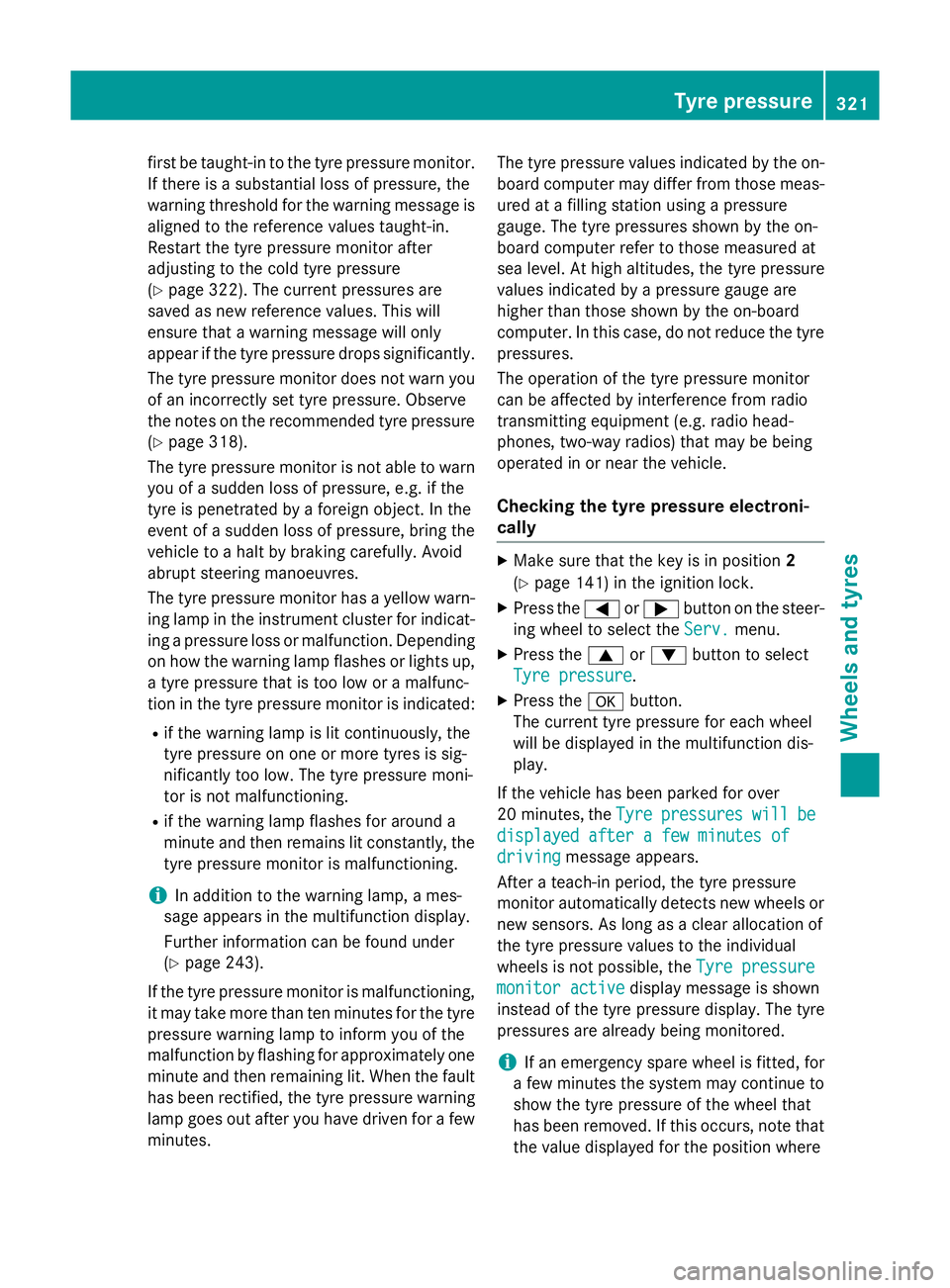
first be taught-in to the tyre pressure monitor.
If there is a substantial loss of pressure, the
warning threshold for the warning message is aligned to the reference values taught-in.
Restart the tyre pressure monitor after
adjusting to the cold tyre pressure
(Y page 322). The current pressures are
saved as new reference values. This will
ensure that a warning message will only
appear if the tyre pressure drops significantly.
The tyre pressure monitor does not warn you
of an incorrectly set tyre pressure. Observe
the notes on the recommended tyre pressure
(Y page 318).
The tyre pressure monitor is not able to warn
you of a sudden loss of pressure, e.g. if the
tyre is penetrated by a foreign object. In the
event of a sudden loss of pressure, bring the
vehicle to a halt by braking carefully. Avoid
abrupt steering manoeuvres.
The tyre pressure monitor has a yellow warn-
ing lamp in the instrument cluster for indicat- ing a pressure loss or malfunction. Depending
on how the warning lamp flashes or lights up, a tyre pressure that is too low or a malfunc-
tion in the tyre pressure monitor is indicated:
R if the warning lamp is lit continuously, the
tyre pressure on one or more tyres is sig-
nificantly too low. The tyre pressure moni-
tor is not malfunctioning.
R if the warning lamp flashes for around a
minute and then remains lit constantly, the tyre pressure monitor is malfunctioning.
i In addition to the warning lamp, a mes-
sage appears in the multifunction display.
Further information can be found under
(Y page 243).
If the tyre pressure monitor is malfunctioning,
it may take more than ten minutes for the tyre pressure warning lamp to inform you of the
malfunction by flashing for approximately one
minute and then remaining lit. When the fault
has been rectified, the tyre pressure warning lamp goes out after you have driven for a few
minutes. The tyre pressure values indicated by the on-
board computer may differ from those meas-
ured at a filling station using a pressure
gauge. The tyre pressures shown by the on-
board computer refer to those measured at
sea level. At high altitudes, the tyre pressure
values indicated by a pressure gauge are
higher than those shown by the on-board
computer. In this case, do not reduce the tyre
pressures.
The operation of the tyre pressure monitor
can be affected by interference from radio
transmitting equipment (e.g. radio head-
phones, two-way radios) that may be being
operated in or near the vehicle.
Checking the tyre pressure electroni-
cally X
Make sure that the key is in position 2
(Y page 141) in the ignition lock.
X Press the =or; button on the steer-
ing wheel to select the Serv. Serv.menu.
X Press the 9or: button to select
Tyre pressure
Tyre pressure.
X Press the abutton.
The current tyre pressure for each wheel
will be displayed in the multifunction dis-
play.
If the vehicle has been parked for over
20 minutes ,the Tyre Tyre pressures
pressures will
willbe
be
displayed after a few minutes of
displayed after a few minutes of
driving driving message appears.
After a teach-in period, the tyre pressure
monitor automatically detects new wheels or
new sensors. As long as a clear allocation of
the tyre pressure values to the individual
wheels is not possible, the Tyre pressure Tyre pressure
monitor active
monitor active display message is shown
instead of the tyre pressure display. The tyre
pressures are already being monitored.
i If an emergency spare wheel is fitted, for
a few minutes the system may continue to
show the tyre pressure of the wheel that
has been removed. If this occurs, note that the value displayed for the position where Tyre pressure
321Wheels and tyres Z
Page 328 of 357
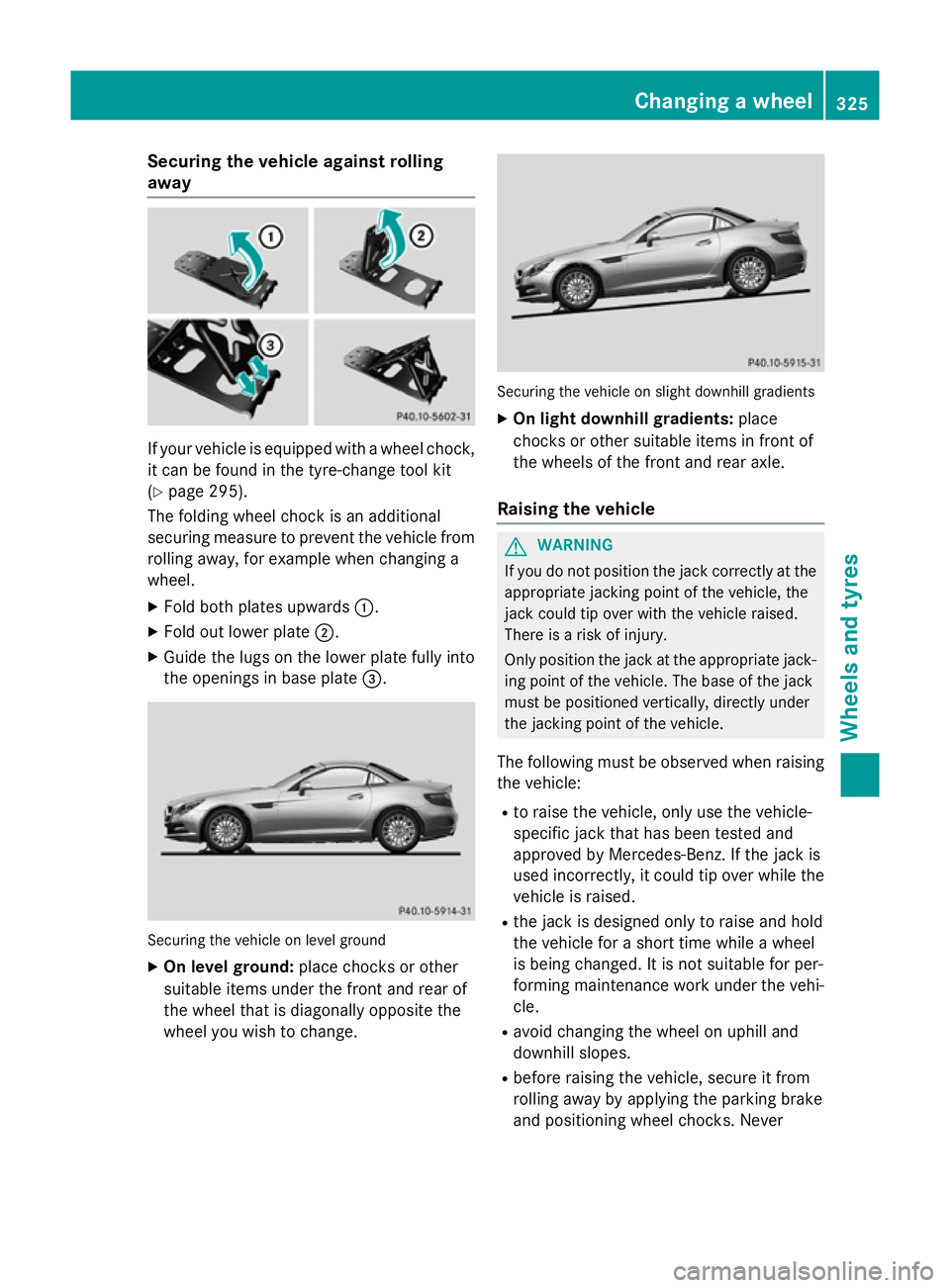
Securing the vehicle against rolling
away
If your vehicle is equipped with a wheel chock,
it can be found in the tyre-change tool kit
(Y page 295).
The folding wheel chock is an additional
securing measure to prevent the vehicle from
rolling away, for example when changing a
wheel.
X Fold both plates upwards :.
X Fold out lower plate ;.
X Guide the lugs on the lower plate fully into
the openings in base plate =.Securing the vehicle on level ground
X On level ground: place chocks or other
suitable items under the front and rear of
the wheel that is diagonally opposite the
wheel you wish to change. Securing the vehicle on slight downhill gradients
X On light downhill gradients: place
chocks or other suitable items in front of
the wheels of the front and rear axle.
Raising the vehicle G
WARNING
If you do not position the jack correctly at the appropriate jacking point of the vehicle, the
jack could tip over with the vehicle raised.
There is a risk of injury.
Only position the jack at the appropriate jack-
ing point of the vehicle. The base of the jack
must be positioned vertically, directly under
the jacking point of the vehicle.
The following must be observed when raising the vehicle:
R to raise the vehicle, only use the vehicle-
specific jack that has been tested and
approved by Mercedes-Benz. If the jack is
used incorrectly, it could tip over while the
vehicle is raised.
R the jack is designed only to raise and hold
the vehicle for a short time while a wheel
is being changed. It is not suitable for per-
forming maintenance work under the vehi-
cle.
R avoid changing the wheel on uphill and
downhill slopes.
R before raising the vehicle, secure it from
rolling away by applying the parking brake
and positioning wheel chocks. Never Changing a wheel
325Wheels and tyres Z
Page 333 of 357
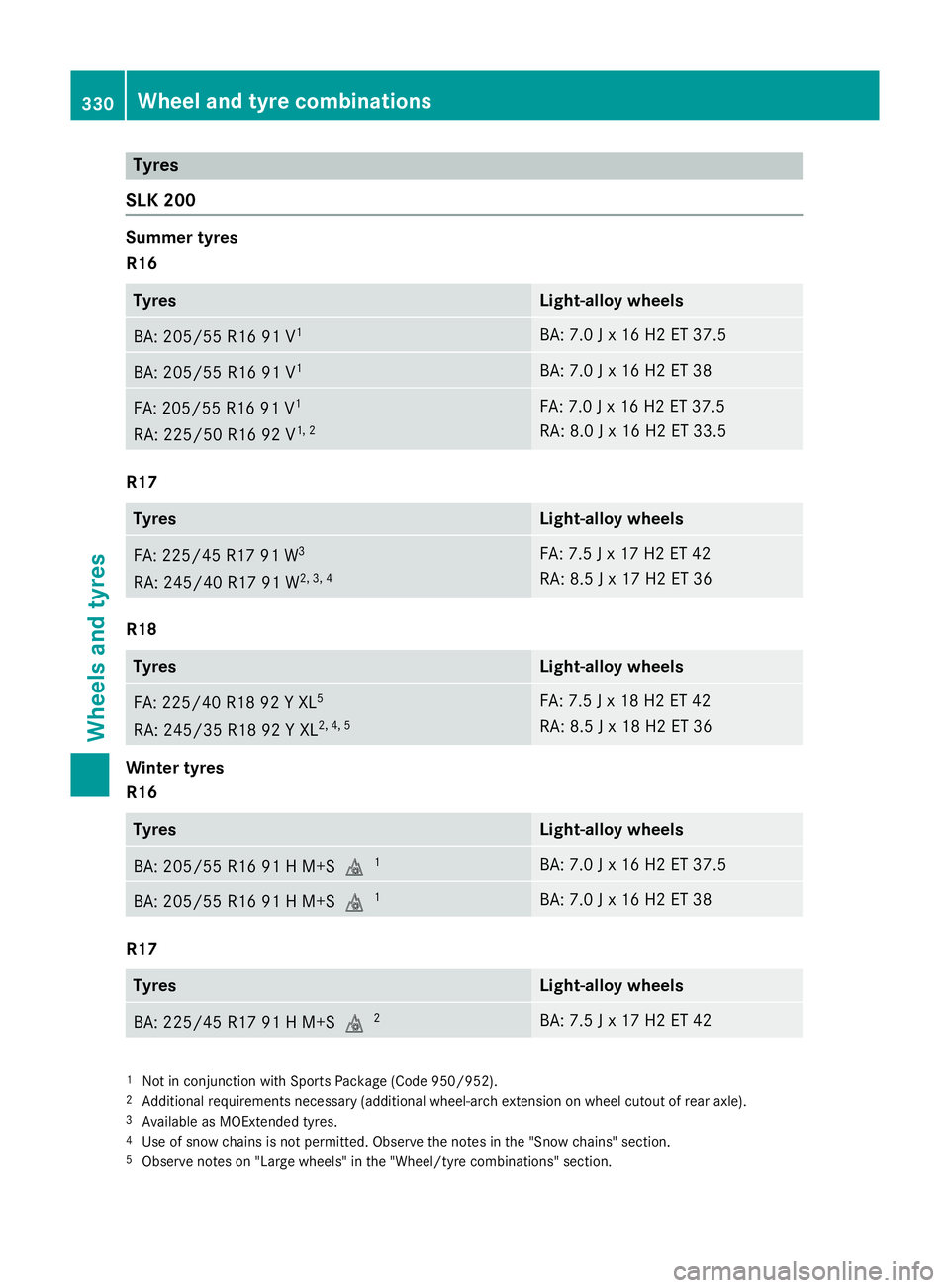
Tyres
SLK 200 Summer tyres
R16
Tyres Light-alloy wheels
BA: 205/5
5 R16 91 V 1 BA: 7.0 J x 16 H2 ET 37.5
BA: 205/55 R16 91 V
1 BA: 7.0 J x 16 H2 ET 38
FA: 205/55 R16 91 V
1
RA: 225/50 R16 92 V 1, 2 FA: 7.0 J x 16 H2 ET 37.5
RA: 8.0 J x 16 H2 ET 33.5
R17
Tyres Light-alloy wheels
FA: 225/45 R17 91 W
3
RA: 245/40 R17 91 W 2, 3, 4 FA: 7.5 J x 17 H2 ET 42
RA: 8.5 J x 17 H2 ET 36
R18
Tyres Light-alloy wheels
FA: 225/40 R18 92 Y XL
5
RA: 245/35 R18 92 Y XL 2, 4, 5 FA: 7.5 J x 18 H2 ET 42
RA: 8.5 J x 18 H2 ET 36
Winter tyres
R16
Tyres Light-alloy wheels
BA: 205/55 R16 91 H M+S
i1 BA: 7.0 J x 16 H2 ET 37.5
BA: 205/55 R16 91 H M+S
i1 BA: 7.0 J x 16 H2 ET 38
R17
Tyres Light-alloy wheels
BA: 225/45 R17 91 H M+S
i2 BA: 7.5 J x 17 H2 ET 42
1
Not in conjunction with Sports Package (Code 950/952).
2 Additional requirements necessary (additional wheel-arch extension on wheel cutout of rear axle).
3 Available as MOExtended tyres.
4 Use of snow chains is not permitted. Observe the notes in the "Snow chains" section.
5 Observe notes on "Large wheels" in the "Wheel/tyre combinations" section. 330
Wheel and tyre combinationsWheels and tyres
Page 334 of 357
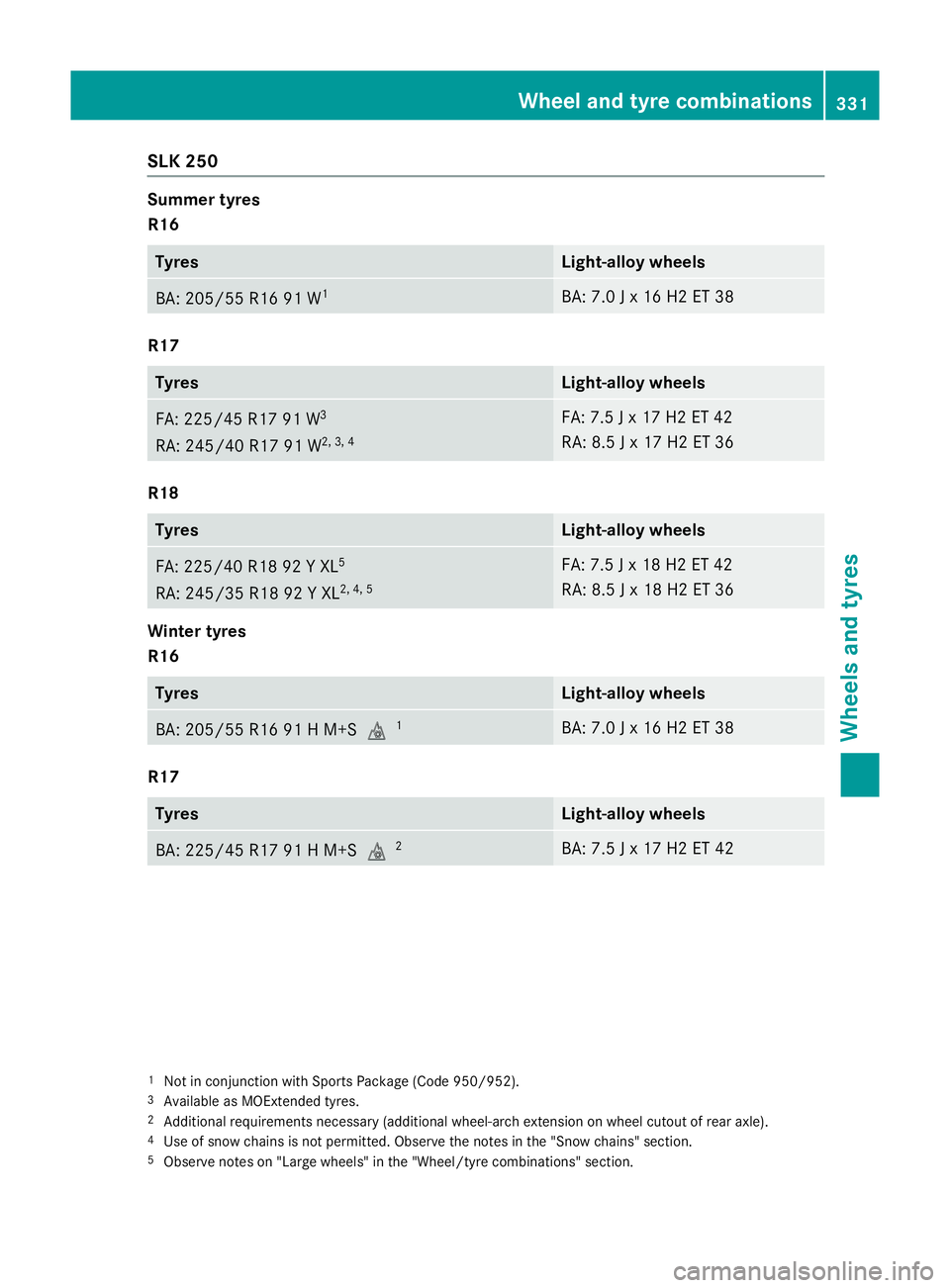
SLK 250
Summer tyres
R16
Tyres Light-alloy wheels
BA: 205/55 R16 91 W
1 BA: 7.0 J x 16 H2 ET 38
R17
Tyres Light-alloy wheels
FA: 225/45 R17 91 W
3
RA: 245/40 R17 91 W 2, 3, 4 FA: 7.5 J x 17 H2 ET 42
RA: 8.5 J x 17 H2 ET 36
R18
Tyres Light-alloy wheels
FA: 225/40 R18 92 Y XL
5
RA: 245/35 R18 92 Y XL 2, 4, 5 FA: 7.5 J x 18 H2 ET 42
RA: 8.5 J x 18 H2 ET 36
Winter tyres
R16
Tyres Light-alloy wheels
BA: 205/55 R16 91 H M+Si
1 BA: 7.0 J x 16 H2 ET 38
R17
Tyres Light-alloy wheels
BA: 225/45 R17 91 H M+Si
2 BA: 7.5 J x 17 H2 ET 42
1
Not in conjunction with Sports Package (Code 950/952).
3 Available as MOExtended tyres.
2 Additional requirements necessary (additional wheel-arch extension on wheel cutout of rear axle).
4 Use of snow chains is not permitted. Observe the notes in the "Snow chains" section.
5 Observe notes on "Large wheels" in the "Wheel/tyre combinations" section. Wheel and tyre combinations
331Wheels and tyres Z
Page 335 of 357
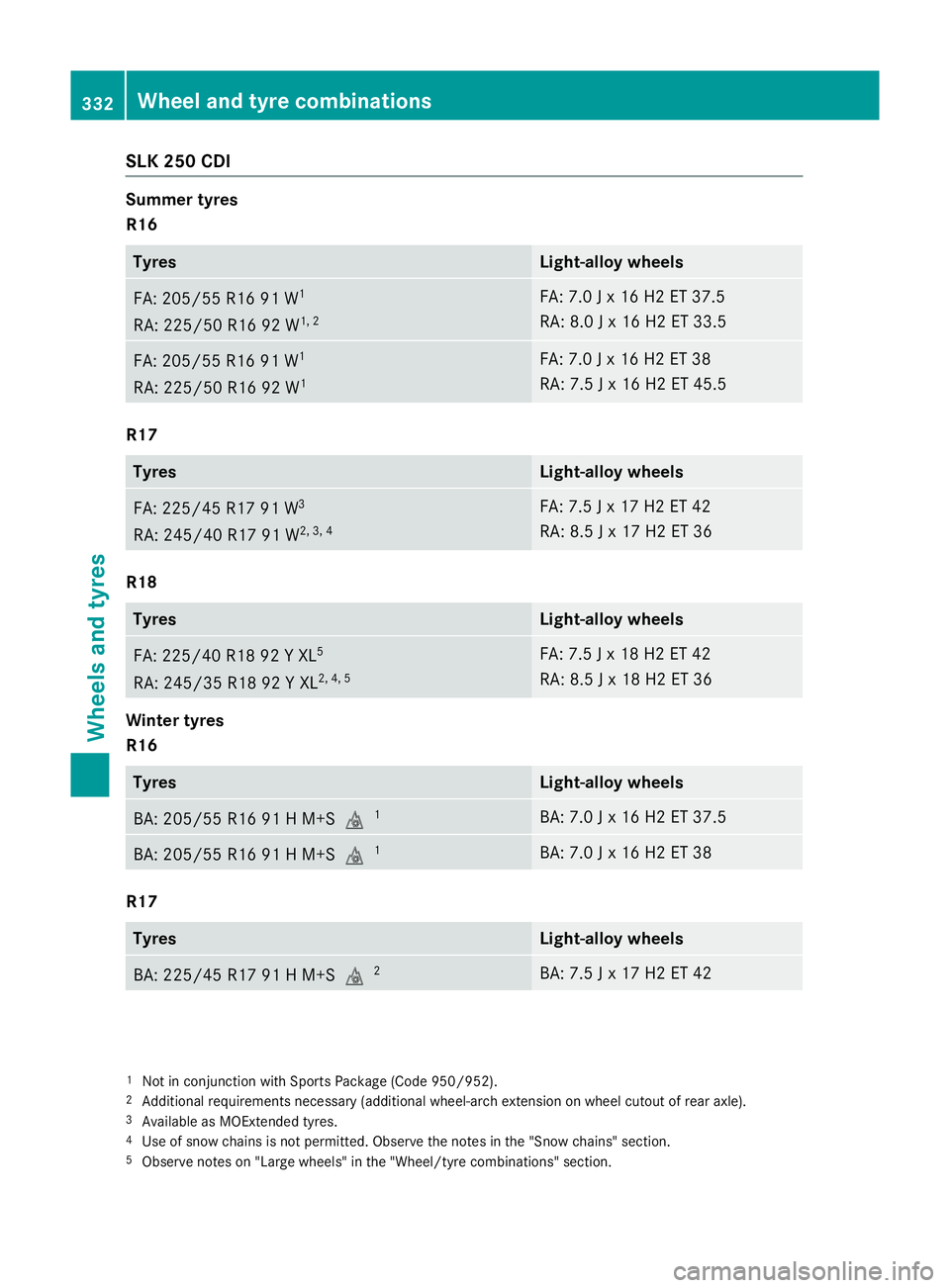
SLK 250 CDI
Summer tyres
R16
Tyres Light-alloy wheels
FA: 205/55 R16 91 W
1
RA: 225/50 R16 92 W 1, 2 FA: 7.0 J x 16 H2 ET 37.5
RA: 8.0 J x 16 H2 ET 33.5
FA: 205/55 R16 91 W
1
RA: 225/50 R16 92 W 1 FA: 7.0 J x 16 H2 ET 38
RA: 7.5 J x 16 H2 ET 45.5
R17
Tyres Light-alloy wheels
FA: 225/45 R17 91 W
3
RA: 245/40 R17 91 W 2, 3, 4 FA: 7.5 J x 17 H2 ET 42
RA: 8.5 J x 17 H2 ET 36
R18
Tyres Light-alloy wheels
FA: 225/40 R18 92 Y XL
5
RA: 245/35 R18 92 Y XL 2, 4, 5 FA: 7.5 J x 18 H2 ET 42
RA: 8.5 J x 18 H2 ET 36
Winter tyres
R16
Tyres Light-alloy wheels
BA: 205/55 R16 91 H M+Si
1 BA: 7.0 J x 16 H2 ET 37.5
BA: 205/55 R16 91 H M+Si
1 BA: 7.0 J x 16 H2 ET 38
R17
Tyres Light-alloy wheels
BA: 225/45 R17 91 H M+Si
2 BA: 7.5 J x 17 H2 ET 42
1
Not in conjunction with Sports Package (Code 950/952).
2 Additional requirements necessary (additional wheel-arch extension on wheel cutout of rear axle).
3 Available as MOExtended tyres.
4 Use of snow chains is not permitted. Observe the notes in the "Snow chains" section.
5 Observe notes on "Large wheels" in the "Wheel/tyre combinations" section. 332
Wheel and tyre combinationsWheels and tyres
Page 336 of 357
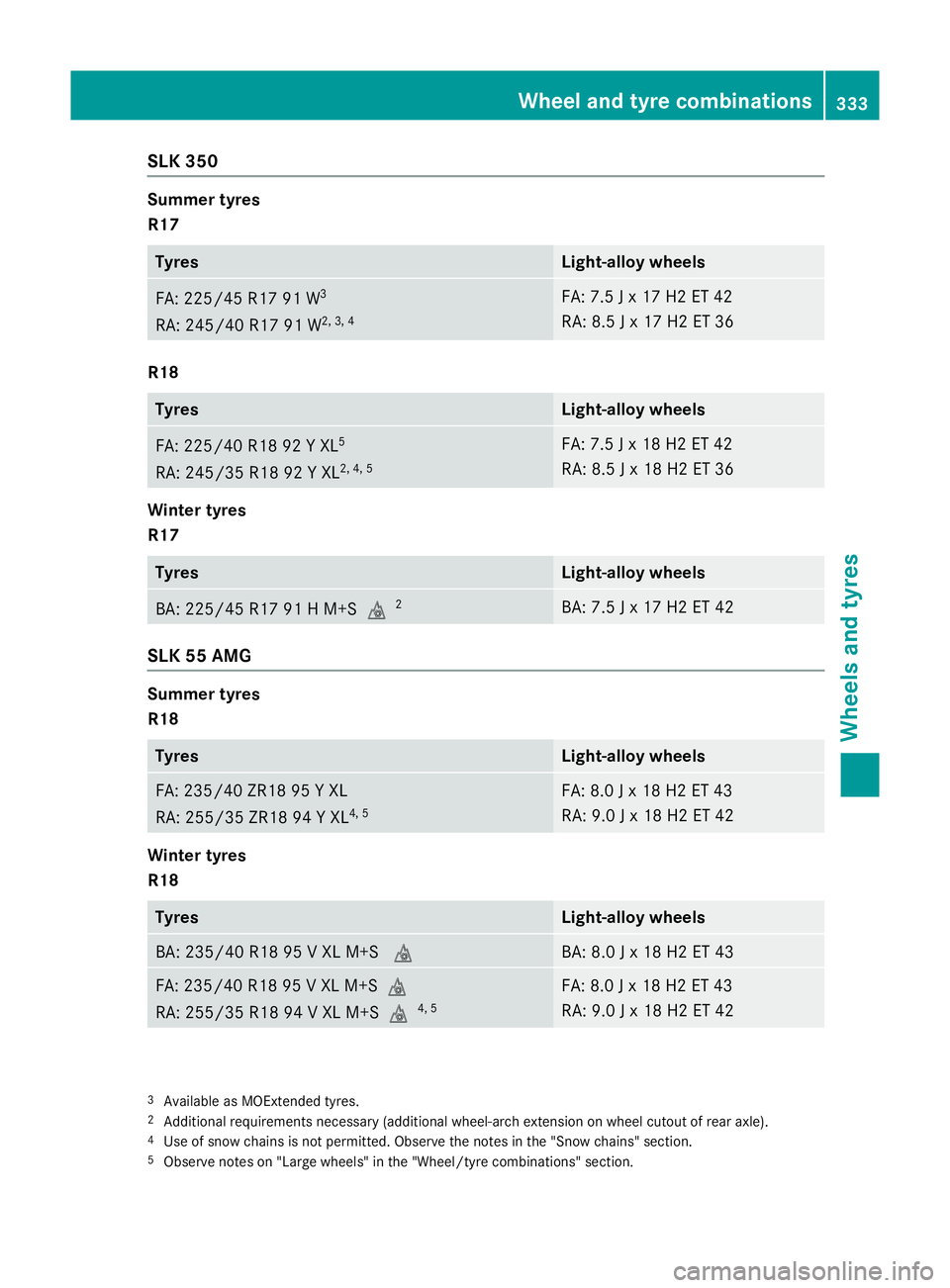
SLK 350
Summer tyres
R17
Tyres Light-alloy wheels
FA: 225/45 R17 91 W
3
RA: 245/40 R17 91 W 2, 3, 4 FA: 7.5 J x 17 H2 ET 42
RA: 8.5 J x 17 H2 ET 36
R18
Tyres Light-alloy wheels
FA: 225/40 R18 92 Y XL
5
RA: 245/35 R18 92 Y XL 2, 4, 5 FA: 7.5 J x 18 H2 ET 42
RA: 8.5 J x 18 H2 ET 36
Winter tyres
R17
Tyres Light-alloy wheels
BA: 225/45 R17 91 H M+Si
2 BA: 7.5 J x 17 H2 ET 42
SLK 55 AMG
Summer tyres
R18
Tyres Light-alloy wheels
FA: 235/40 ZR18 95 Y XL
RA: 255/35 ZR18 94 Y XL 4, 5 FA: 8.0 J x 18 H2 ET 43
RA: 9.0 J x 18 H2 ET 42
Winter tyres
R18
Tyres Light-alloy wheels
BA: 235/40 R18 95 V XL M+S
i BA: 8.0 J x 18 H2 ET 43
FA: 235/40 R18 95 V XL M+Si
RA: 255/35 R18 94 V XL M+Si 4, 5 FA: 8.0 J x 18 H2 ET 43
RA: 9.0 J x 18 H2 ET 42
3
Available as MOExtended tyres.
2 Additional requirements necessary (additional wheel-arch extension on wheel cutout of rear axle).
4 Use of snow chains is not permitted. Observe the notes in the "Snow chains" section.
5 Observe notes on "Large wheels" in the "Wheel/tyre combinations" section. Wheel and tyre combinations
333Wheels and tyres Z
Page 339 of 357
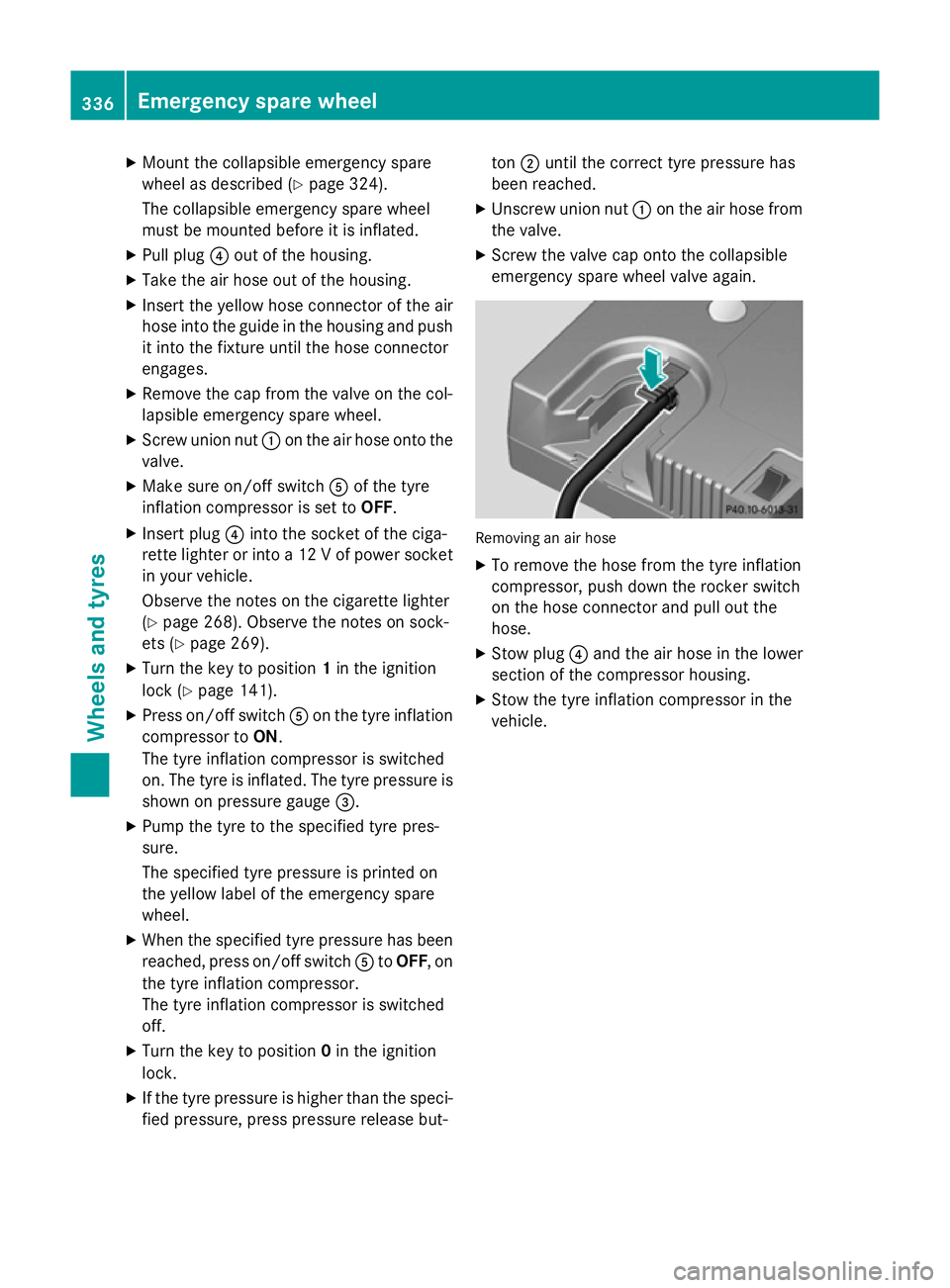
X
Mount the collapsible emergency spare
wheel as described (Y page 324).
The collapsible emergency spare wheel
must be mounted before it is inflated.
X Pull plug ?out of the housing.
X Take the air hose out of the housing.
X Insert the yellow hose connector of the air
hose into the guide in the housing and push it into the fixture until the hose connector
engages.
X Remove the cap from the valve on the col-
lapsible emergency spare wheel.
X Screw union nut :on the air hose onto the
valve.
X Make sure on/off switch Aof the tyre
inflation compressor is set to OFF.
X Insert plug ?into the socket of the ciga-
rette lighter or into a 12 V of power socket
in your vehicle.
Observe the notes on the cigarette lighter
(Y page 268). Observe the notes on sock-
ets (Y page 269).
X Turn the key to position 1in the ignition
lock (Y page 141).
X Press on/off switch Aon the tyre inflation
compressor to ON.
The tyre inflation compressor is switched
on. The tyre is inflated. The tyre pressure is shown on pressure gauge =.
X Pump the tyre to the specified tyre pres-
sure.
The specified tyre pressure is printed on
the yellow label of the emergency spare
wheel.
X When the specified tyre pressure has been
reached, press on/off switch AtoOFF, on
the tyre inflation compressor.
The tyre inflation compressor is switched
off.
X Turn the key to position 0in the ignition
lock.
X If the tyre pressure is higher than the speci-
fied pressure, press pressure release but- ton
;until the correct tyre pressure has
been reached.
X Unscrew union nut :on the air hose from
the valve.
X Screw the valve cap onto the collapsible
emergency spare wheel valve again. Removing an air hose
X
To remove the hose from the tyre inflation
compressor, push down the rocker switch
on the hose connector and pull out the
hose.
X Stow plug ?and the air hose in the lower
section of the compressor housing.
X Stow the tyre inflation compressor in the
vehicle. 336
Emergency spare wheelWheels and tyres